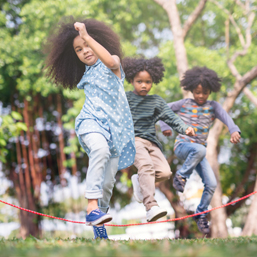
I love our child-friendly neighborhood. In the spring, the streets are usually filled with kids playing street hockey, playgrounds ring with the squeals and calls of children, and fields fill with throngs of kids enjoying orange slices after evening soccer games. Getting the kids outside for free play and fresh air is well worth the effort, even if it’s for ten minutes at a time between conference calls.
Active play helps uncertain and lonely kids recover a sense of normalcy and ease anxiety, helps them meet Canada’s 24-hour movement guidelines (csepguidelines.ca), and develops their movement skills, which is one of the key components of physical literacy.
Even knowing how great it is for their mental and physical health, it’s not always easy to motivate my kids. In fact, sometimes it’s next to impossible just to get them to put on shoes and get out the door, and my optimistic suggestions for activities are often met with groans.
One idea my two boys didn’t (completely) grumble about was creating a DIY obstacle course in the backyard.
They didn’t have access to piles of wood pallets, ziplines, or enough lumber to build a warped wall, but they did find abandoned stumps that we hadn’t picked up before winter (oops!), searched under the porch for planks of sturdy wood, dragged out old pool noodles, and rolled a quartet of tires out of the garage.
They planned, constructed, problem-solved, and came up with a meandering maze of items that had them jumping, climbing, balancing, ‘swimming,’ and dancing.
And surprise of all surprises – they were cooperating!
10 things you can use to create a DIY obstacle course
To get kids outside, help them flex their creative muscles, and have them get an all-over workout, here are some inexpensive everyday items that you can use to get your kids started creating an obstacle course of their own:
Crab walk or bear crawl through a rainbow of hoops, practice movement skills while hopping on one foot or jumping through taped-together rings on the ground, zig-zag through vertical noodles stuck in the ground, and work on throwing with a giant target game.
Get ready to walk the plank! Or maybe it’s a tightrope, a gymnastics beam, or a log over a ravine. Place a beam across a round stump and make a seesaw to walk across. These activities will challenge kids’ coordination and vestibular system.
Crawl-through fabric tunnels make a perfect obstacle. If you don’t have one at home, a large cardboard box or a blanket draped over two chairs is also fun.
Place a pool noodle across two stumps and create kid-friendly (and short!) hurdles to run and jump over. Step, step, step across them, or roll one through the grass. Use the stumps as anchors to create a rope maze to belly crawl under.
Use a bat, hockey stick, or even a broom to help develop hand-eye coordination while coaxing the ball across a finish line. Want a bigger challenge? Try using a balloon.
If you have plywood, 2x4s, tools, and time, these slanted steps look amazing. I’m going to scour the garage and see if we can build a set.
Sew your own at home with dried beans or rice and some scrap fabric, and toss them onto a board painted with numbered circles, or try to get the most into a bucket or laundry basket. Toss all your bags and then move on to the next obstacle!
A skipping rope can be the starting line for a standing broad jump, an easy tightrope when placed on the ground, or used in a game of riverbank.
Fill up plastic water bottles or milk cartons to use as bowling pins. Place the bottles in two rows and use any large round ball to try to knock them down. It’s a great activity for building arm strength, coordination, and fine motor control.
Tie a hula hoop to a tree branch or clothesline to jump through, lay hoops on the ground in a row or pattern where kids must hop or step from one to next, or hold the hoop in two hands and skip with it. You can even try making your own hoops.
Try these variations to make your obstacle course more challenging:
If you don’t have the luxury of a yard or grassy area, you can still work on balance, jumping, and agility using chalk to make an obstacle course on a driveway or an (empty) sidewalk. There are so many ways to get active and have fun outside.
Safety tips
Make sure your yard is free of sharp stones, and clear the course of any loose or broken material.
While my kids are older (seven and 11) and fairly self-sufficient in our yard, younger children will need help and supervision when searching for loose play items, as well as to construct and maneuver through the course.
Remember that water and snow can make your course slippery and unsafe, so steer children to other activities in wet weather.
Move any objects that you don’t want kids to play with. Your antique bird bath may not make a good obstacle.
Wear proper footwear. Though my kids would rather be in flip-flops or barefoot, when playing on wood or leaping across tires, it’s best to wear closed-toe shoes with a non-skid sole.
Reprinted with permission from Active for Life. Active for Life is a non-profit organization committed to helping parents raise happy, healthy, physically literate kids. For more articles, visit activeforlife.com.
See our related articles:
Playgrounds and obstacle courses
Calgary’s Child Magazine © 2024 Calgary’s Child